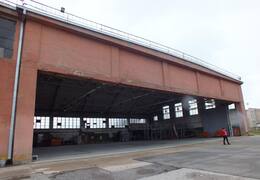Šilėnai bombing range
During the interwar period, a bombing range operated in the Šilėnai marshland near Šiauliai, where Lithuanian Air Force bombing and shooting exercises were conducted. The concrete observation towers that have survived to this day remind us of the existence of this range.
The Šilėnai training ground, located about 6 kilometers from the Zokniai airfield in the direction of Radviliškis, was an important training base for the Lithuanian military aviation. In the summer of 1939, important tests were held here, which military pilot Antanas Mikutis describes as follows: "one fine day, the chief of aviation, Gen. A. Gustaitis, flew to Zokniai with an airplane we had never seen before. It was a light attack bomber ANBO-VIII undergoing testing." He says that "A. Gustaitis decided to move the final phase of the tests to the Šilėnai training ground, i.e. to drop a series of training bombs on a target on the ground while diving."
A special surveillance system was installed at the test site, which Mikutis describes in detail: "Three towers were built on the ground (at the tracking point), arranged at the corners of a triangle, approximately a kilometer apart, with a target in the center. The trackers had to record the bomb's fall location from their sectors with the help of a certain sight with circular degree divisions and write it down."
The pilot says about the exercises themselves: "A fixed optical sight (a long tube - binoculars) was installed in the reconnaissance seat through the bottom of the plane, with the help of which an object on the ground was aimed. Accuracy depended greatly on how the pilot carried out reconnaissance commands, because he could not see the target below him." The flights took place at an altitude of 1000 m, and "during one flight, several approaches were made over the polygon (specifically - S circles) and during each such approach over the target, one cement bomb was dropped, which exploded upon falling and caused a cloud of smoke."
In addition to bombing exercises, other training was also conducted at the training ground. According to Mikutis, "new exercises were added in the spring - shooting at ground targets at the Šilėnai training ground, air battles with photo machine guns, adjusting artillery fire, and so on." Special exercises were carried out over Lake Rėkyva: "Several times we had to fly over Lake Rėkyva and shoot at the shadow of another plane on the water. The posing plane was ANBO-51, and its scout would mark the hits of the shooting plane on a piece of paper, because it was very visible from above."
Related timeline
Related objects
Zokniai airfield
In the part of Šiauliai city called Zokniai, an airfield has been operating since the interwar period, later becoming an airport.
In 1931, it was decided to establish an airfield in Zokniai, the flat fields and gravelly soil were perfect for airplanes. On June 1, the 3rd and 4th reconnaissance squadrons, equipped with LVG C.VI and Albatros C.XV airplanes, were transferred from Kaunas to Zokniai. Hangars, a headquarters building and barracks were built, and Major Leonardas Peseckas became the first commander of the base.
As the capabilities of the Lithuanian military aviation grew, the Zokniai airfield expanded: new hangars, aircraft repair shops were built here, and a bombing range was established near Šilėnai. In 1937, the 5th squadron with Letov Š-20 and FIAT CR20 fighters was transferred to Zokniai, and in 1938 these old fighters were replaced by modern Gloster Gladiators, which achieved excellent results in the Finnish-USSR (Winter) War.
In 1936, during the military reforms of S. Raštikis, military aviation was decentralized, and Zokniai airfield became one of the main military bases of the country. The military aviation forces expanded here, aviation workshops were established, which contributed to the maintenance and repair of aircraft, and later famous designers, such as Bronius Oškinis, worked there. Zokniai airfield became a strategic point, the importance of which grew due to the deployment of nuclear weapons nearby during the Soviet era.
In 2005, at the request of city businessmen, the Šiauliai City Municipality Enterprise “Šiauliai Airport” was established. After Lithuania became a member of NATO, the repair of the airfield runways also began: in 2005, the reconstruction of the backup runway was carried out. Funds were allocated by NATO.
The reconstruction of the main runway was officially completed with the grand opening of the runway on October 26, 2006. The specialists who conducted the flight survey and certification of the reconstructed airfield recognized it as the best in all of Eastern Europe.
Zokniai Air Base Hangar (KVR)
The Zokniai Aviation Base hangar, also known as the Antanas Gustaitis hangar, was built in Šiauliai near the railway line.
The hangar was built around 1936, it is believed that the author of the project was engineer Antanas Gustaitis. The hangar was intended for aircraft of the military aviation base. It is one of the first hangars built in the First Republic of Lithuania, reflecting the development of interwar aviation - Lithuanian ANBO aircraft were assembled there.
ANBO (abbreviation for Antanas Nori Būti Ore) – aircraft designed by the same engineer A. Gustaitis and manufactured in Kaunas Aviation Workshop. In 1925–39, 66 aircraft were manufactured (single-seat sports, double-seat training and reconnaissance, double-seat light bomber with an automatically variable pitch propeller). All types of aircraft were of semi-metal construction with air-cooled engines. 1934-06-25 – 07-19 three ANBO IV aircraft flew around Europe.
Later, the hangar began to repair aircraft and helicopters of the Latvian Air Force (LAF): the fuel and lubricants in their tanks were pumped in advance into underground reinforced concrete tanks located further away from the hangar, and during the repair, the aircraft and helicopters were transported by tow truck.
The building is still used for the needs of the Šiauliai Air Base. In 2010, the Air Base Day was celebrated there.





